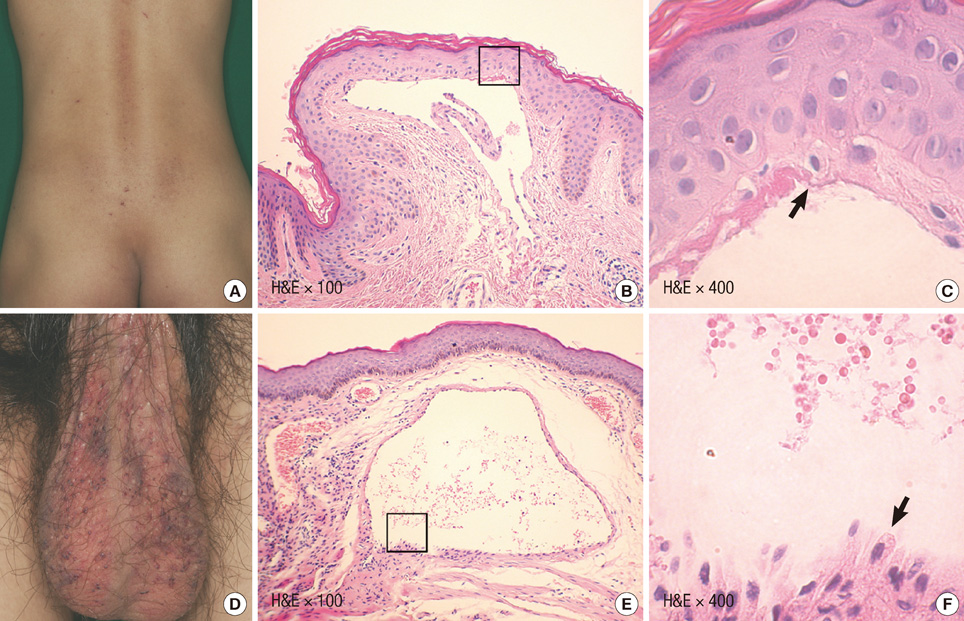J Korean Med Sci.
2011 Jul;26(7):966-970. 10.3346/jkms.2011.26.7.966.
A Case of Fabry's Disease with Congenital Agammaglobulinemia
- Affiliations
-
- 1Department of Dermatology, Dong-A University College of Medicine, Busan, Korea. khkim@dau.ac.kr
- 2Department of Nephrology, Dong-A University College of Medicine, Busan, Korea.
- 3ES Esthetic & Laser Center, Busan, Korea.
- KMID: 1094273
- DOI: http://doi.org/10.3346/jkms.2011.26.7.966
Abstract
- Fabry's disease is an X-linked lysosomal storage disorder caused by abnormalities in the alpha-galactosidase A (GLA) gene, which leads to a GLA deficiency and to the intracellular deposition of globotriaosylceramide (Gb3) within vascular endothelium and other tissues. It manifests as progressive multiple organ dysfunctions caused by the deposition of Gb3. On the other hand, congenital agammaglobulinemia is usually caused by mutations in Bruton's tyrosine kinase (Btk) gene with X-linked dominence, suppresses B cell maturation, and causes recurrent pyogenic infections. In former reports, the distance between the loci in the Xq22 region of the human X chromosome was found to be about 69 kilobases. A 23-yr-old man diagnosed with congenital agammaglobulinemia at age 5, showed typical clinical and laboratory and histopathological findings of Fabry's disease. The genetic basis of this combination of the two syndromes was studied in this patient. Here, we report a case of Fabry's disease with congenital agammaglobulinemia.
MeSH Terms
Figure
Reference
-
1. Brady RO, Gal AE, Bradley RM, Martensson E, Warshaw AL, Laster L. Enzymatic defect in Fabry's disease. Ceramidetrihexosidase deficiency. N Engl J Med. 1967. 276:1163–1167.2. Clarke JT. Narrative review: Fabry disease. Ann Intern Med. 2007. 146:425–433.3. Brady RO, Murray GJ, Moore DF, Schiffmann R. Enzyme replacement therapy in Fabry disease. J Inherit Metab Dis. 2001. 24:Suppl 2. 18–24.4. Nomura K, Kanegane H, Karasuyama H, Tsukada S, Agematsu K, Murakami G, Sakazume S, Sako M, Tanaka R, Kuniya Y, Komeno T, Ishihara S, Hayashi K, Kishimoto T, Miyawaki T. Genetic defect in human X-linked agammaglobulinemia impedes a maturational evolution of pro-B cells into a later stage of pre-B cells in the B-cell differentiation pathway. Blood. 2000. 96:610–617.5. Tsukada S, Saffran DC, Rawlings DJ, Parolini O, Allen RC, Klisak I, Sparkes RS, Kubagawa H, Mohandas T, Quan S, Belmont JW, Cooper MD, Conley ME, Witte ON. Deficient expression of a B cell cytoplasmic tyrosine kinase in human X-linked agammaglobulinemia. Cell. 1993. 72:279–290.6. Mehta A, Ricci R, Widmer U, Dehout F, Garcia de Lorenzo A, Kampmann C, Linhart A, Sunder-Plassmann G, Ries M, Beck M. Fabry disease defined: baseline clinical manifestations of 366 patients in the Fabry Outcome Survey. Eur J Clin Invest. 2004. 34:236–242.7. MacDermot KD, Holmes A, Miners AH. Anderson-Fabry disease: clinical manifestations and impact of disease in a cohort of 98 hemizygous males. J Med Genet. 2001. 38:750–760.8. Zarate YA, Hopkin RJ. Fabry's disease. Lancet. 2008. 372:1427–1435.9. Bernstein HS, Bishop DF, Astrin KH, Kornreich R, Eng CM, Sakuraba H, Desnick RJ. Fabry disease: Six gene rearrangement and an exonic mutation in the alpha-galactosidase gene. J Clin Invest. 1989. 83:1390–1399.10. Väliaho J, Smith CI, Vihinen M. BTKbase: the mutation database for X-linked agammaglobulinemia. Hum Mutat. 2006. 27:1209–1217.11. Conley ME, Broides A, Hernandez-Trujillo V, Howard V, Kanegane H, Miyawaki T, Shurtleff SA. Genetic analysis of patients with defects in early B-cell development. Immunol Rev. 2005. 203:216–234.12. Ochs HD, Notarangelo LD. X-linked immunodeficiencies. Curr Allergy Asthma Rep. 2004. 4:339–348.13. Conley ME. Molecular approaches to analysis of X-linked immunodeficiencies. Annu Rev Immunol. 1992. 10:215–238.14. Ohta Y, Haire RN, Litman RT, Fu SM, Nelson RP, Kratz J, Kornfeld SJ, de la Morena M, Good RA, Litman GW. Genomic organization and structure of Bruton agammaglobulinemia tyrosine kinase: localization of mutations associated with varied clinical presentations and course in X chromosome-linked agammaglobulinemia. Proc Natl Acad Sci U S A. 1994. 91:9062–9066.15. Miller AT, Berg LJ. New insight into the regulation and functions of Tec family tyrosine kinases in the immune system. Curr Opin Immunol. 2002. 14:331–340.16. Oeltjen JC, Liu X, Lu J, Allen RC, Muzny D, Belmont JW, Gibbs RA. Sixty-nine kilobases of contiguous human genomic sequence containing the alpha-galactosidase A and Bruton's tyrosine kinase loci. Mamm Genome. 1995. 6:334–338.






